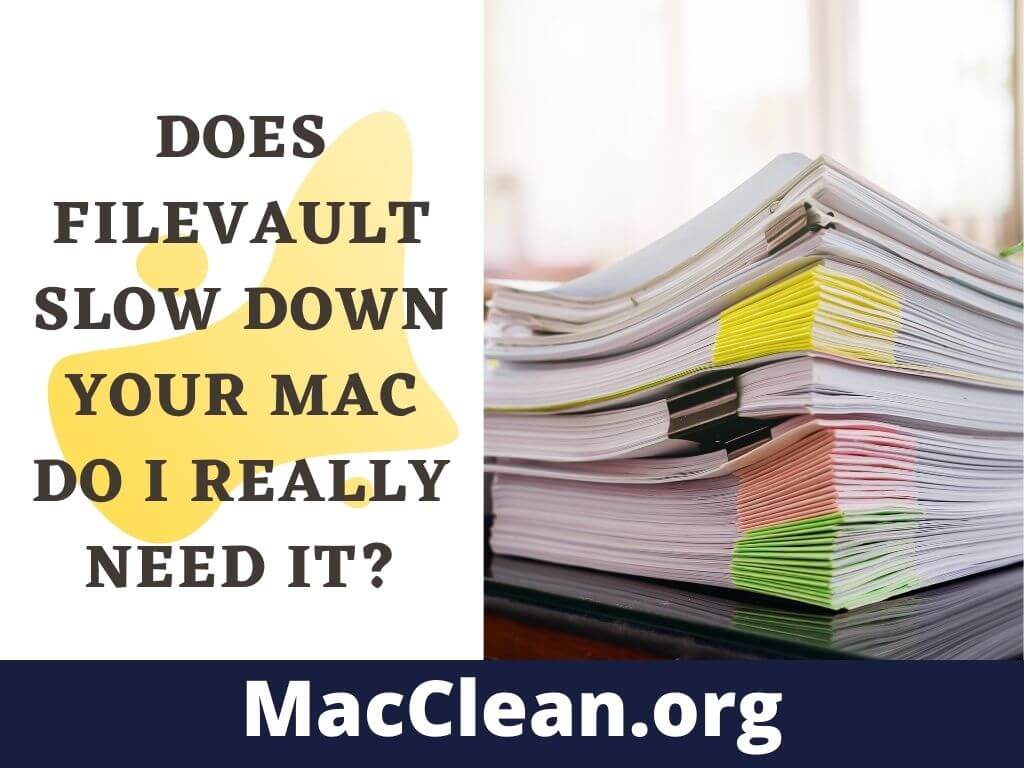Does FileVault slow down your Mac, do I really need FileVault? This is a question that many people have asked, and the answer is not always clear.
FileVault is a feature of the macOS operating system that encrypts the data stored on your hard drive. If you have FileVault enabled, you can rest assured that no one can access your personal files without your permission. However, the tradeoff is that FileVault slows down the performance of your Mac by a significant amount. It’s important to understand how FileVault works and what it does to your Mac, so you know when and how to disable FileVault.
FileVault is a feature in macOS that encrypts your files and folders. It’s a great feature for securing your data if you’re a frequent user of the cloud or a big fan of password managers. But it can slow down your Mac if you’re not careful.
In this article, we will explore the effects of FileVault on Mac performance, and offer some tips to help you get the most out of your system.
What is FileVault and what does it do for your Mac security?
FileVault is a security feature that is built into every Mac. It encrypts the contents of your hard drive, making it difficult for anyone to access your data without your password. This can help protect your data if your Mac is ever lost or stolen.
There are two main types of encryption, software-based and hardware-based.
- Software-based encryption is the most common, and it is what FileVault uses. Hardware-based encryption is not as common, but it is more secure. It requires a special piece of hardware, called a security envelope, to be attached to your Mac.
- Software-based encryption is more convenient because it does not require any additional hardware. However, it is not as secure as hardware-based encryption. If someone can get access to your computer, they can also access your data if it is encrypted with software-based encryption.
- Hardware-based encryption is more secure because it cannot be bypassed without the security envelope. However, it is less convenient because you need to attach the envelope to your computer. If you forget the envelope, you will not be able to access your data.
FileVault uses software-based encryption, so it is not as secure as hardware-based encryption. However, it is still a good security measure to take if you are concerned about the safety of your data.
How To Enable FileVault On Your Mac – Do I Really Need It?
To enable FileVault on your Mac, simply follow the guide to do it easily:
- Open System Preferences and click on Security & Privacy. Click on the FileVault tab and then click the Turn On FileVault button.
- You will be asked to create a password for your Mac. This is the password that you will need to unlock your hard drive when you start your computer. Make sure to choose a strong password and write it down somewhere safe.
- You will also be asked to create a recovery key. This is a backup of your password that can be used if you forget your password or lose your computer. It is important to keep this key safe because without it you will not be able to unlock your hard drive.
- After you have created a password and recovery key, click the Restart button. Your computer will restart and begin encrypting your hard drive. This process can take a few hours, so make sure to do it when you have some time to spare.
- Once your hard drive is encrypted, you will see a lock icon in the upper-left corner of your screen. This indicates that FileVault is enabled and your data is encrypted.
If you want Disable:
- To disable FileVault, open System Preferences and click on Security & Privacy. Click on the FileVault tab and then click the Turn Off FileVault button. You will be asked to enter your password and recovery key. Once you have entered these, FileVault will be disabled and your hard drive will be decrypted.
- Keep in mind that if you disable FileVault, your data will no longer be encrypted. This means that if your computer is lost or stolen, someone could access your data without your password. Therefore, it is important to only disable FileVault if you are sure that you do not need it.
Enabling FileVault does not impact the performance of your Mac while you are using it. However, it can slow down your computer when you start it up or shut it down because the encryption process takes some time.
The Impact Of FileVault On Mac Performace
Are you wondering what the impact of Filevault on Mac performance is? Are you confused about the difference between Disk Utility and Disk First Aid? Or, are you wondering why your computer takes so long to boot?
In this post, we will clear up all the confusion and show you exactly what the impact of Filevault is on your Mac’s performance. This will help you to know whether you should turn off Filevault or not.
Before we begin with our guide, let’s first talk about the difference between Disk Utility and Disk First Aid. What Is The Difference Between Disk Utility And Disk First Aid?
Disk Utility and Disk First Aid are two apps that are used to manage the hard drive. Both of these apps can be used to repair or restore your hard drive. They both have similar functionality.
If I talk about the Impact Of Filevault On Mac Performance? Filevault is a feature that comes with OS X Lion. It encrypts the contents of your hard drive. Doing this ensures that no one can access your files if your Mac is stolen or lost. However, this encryption process makes your computer take longer to boot and shutdown. If you have turned on Filevault and used your Mac for a long time, it can make your Mac slower than normal. It can also make your Mac less responsive.
How To Know That Is FileVault Slowing Down Your MacBook
If you are concerned that FileVault is slowing down your Mac, there are a few ways to figure it out. The first is to open the Activity Monitor and look for the disk usage percentage. If this number is high, it means that your computer is spending a lot of time encrypting or decrypting data.
The second way to tell if FileVault is impacting your Mac’s performance is to check the startup time. To do this, open System Preferences and click on Users & Groups. Click on the Login Items tab and then look at the list of items that are set to launch when you start your computer. If there are a lot of items listed, it means that your computer is taking a long time to start up.
You can also check the shutdown time by opening System Preferences and click on Energy Saver. Click on the Battery tab and then look at the amount of time it takes for your computer to shut down. If this number is high, it means that FileVault is slowing down your Mac when you shut it down.
Tips To Speed Up Your Mac With Or Without FileVault Enabled
- If you are not using FileVault, disable it to speed up your Mac startup and shutdown time.
- Try using hardware-based encryption instead of software-based encryption for better performance.
- Delete unnecessary files and programs from your disk drive to free up space and improve performance.
Conclusion:
So, does FileVault slow down your Mac? The answer is a little complicated. It depends on how you use your computer and what type of files you store on it.
Overall, though, we found that the performance impact of FileVault was minor for most users. If you’re looking for added security and peace of mind, we recommend turning on FileVault encryption. Just be prepared for a very small drop in performance if you do. Have you turned on FileVault or are considering doing so? Let us know how it goes in the comments below!
Read Also:

